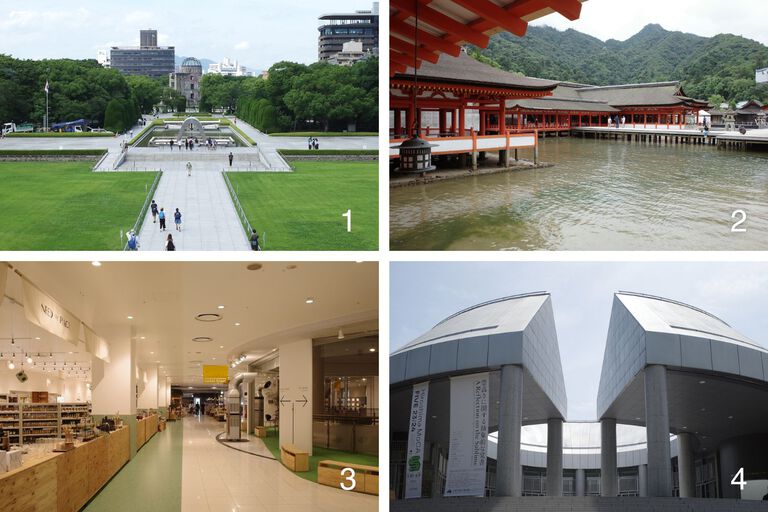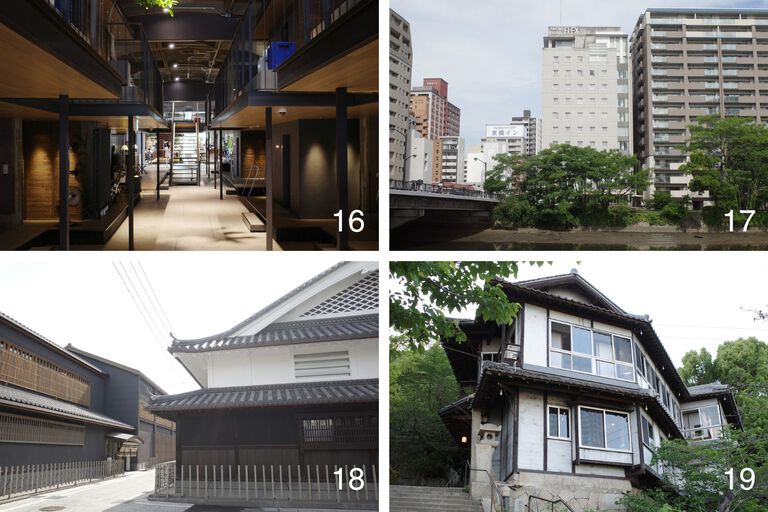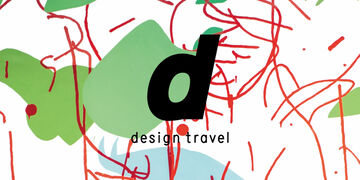Hiroshima as a Testament to Friendship That Creates the Future
Beyond the connotation of a tragic legacy and prayer for peace, the word "Hiroshima" now harbors the power to connect people, bind the islands of the vast Seto Inland Sea, and create a new future together. We hold the conviction that the reconstruction of Hiroshima is complete. In Hiroshima today, the "co-creation lifestyle" that could be considered friendship is being fostered, leading people to the world and to hope.

d design travel HIROSHIMA
One Note on the Cover : Yuki Tejima "AID#60"
We were reminded of how impressive Yuki Tejima is as an artist while viewing his work at Hiroshima MOCA. The AID series embodies his feelings on Hiroshima, as well as its sights and future. AID expresses a Hiroshima that, 80 years since the atomic bombing, has not only recovered but embarked upon a renaissance. This huge piece on Peace Boulevard is now the local scenery and was one of my biggest highlights.

1. Peace Memorial Park
2. Itsukushima Shrine
3. iti SETOUCHI
4. Hiroshima City Museum of Contemporary Art (Hiroshima MOCA)


Learning From Hiroshima
Landscape With a River
"Hiroshima City was built on the estuary delta of the Otagawa River. The practice of "iron sand mining" artificially altered the
topography and led to sediment accumulation at the estuary. Hiroshima Castle was built at the top of this delta in 1589, which is
believed to be the city's origin.
By Jun Imada

5. Etajima Potage & Restaurant Bricolage17
6. Hiroshima Andersen
7. LOPEZ


Hiroshima's "Home Grown" Meal
Above photo, clockwise from the top: Fried Nebuto: Part of the Setonaikai's small fish cuisine culture. Nebuto is the local name for red bigeye. An excellent accompaniment to sake. Nigome: A Jodo Shinshu vegetarian dish of diced root vegetables, always including adzuki beans associated with Saint Shinran. Peanuts; Omasari peanuts from Waki Farm, carefully nurtured through meticulous field and soil preparation. Okonomiyaki: A layered dish of thin batter, noodles, cabbage and egg. A flavor that sustained people through post-war food shortages. Eba-Maki: A nori roll filled with rice, Hiroshima-na pickles, white sesame seeds, and bonito flakes.

8. SHAQUDA
9. santo
10. Miyajima Kogei Seisakusho
11. USHIO CHOCOLATL


Exploring Hiroshima's Production Centers
Fukuyama Denim
"Are jeans Long-Life Design? Color fading is what makes jeans appealing. Two things facilitate this; poor indigo dye retention and proprietary thread dyeing methods. Bingo-gasuri includes a rope-dyeing method wherein only the surface is dyed while the inside is left white. So, when the outer surface is worn down, the inner white appears readily."
By Hideto Shindo (Editor-in-Chief of "d design travel")

12. TEA STAND GEN
13. minagarten
14. Sagotani Farm
15. Shinshoji Zen Museum and Gardens


An Organization Maintaining Unique Traits within Hiroshima Prefecture
The Onomichi Akiya Saoseo Project
"Established in 2008, the Onomichi Akiya Saisei Project is an NPO led by local Masako Toyota, aiming to develop an area unique only to Onomichi based on five pillars: architecture, environment, community, tourism and art. While there is growing attention on similar initiatives in other regional towns, the aim for Onomichi is to protect its unique traits and to maintain its unique lifestyles. Rather than looking at how to solve the problem, Onomichi is working to develop alongside its akiya."
By Hideto Shindo (Editor-in-Chief of "d design travel")

16. HOTEL CYCLE
17. HOTEL FLEX
18. Azumi Setoda
19. Onomichi Guest House Miharashi-tei)


Mingei (Arts and Crafts) of Hiroshima
Light
"He managed to escape death by instantly throwing himself on the floor, but other passengers in the car were covered in blood and glass shards. He lost not only his home, but also his relatives and friends and acquaintances. It was only after hearing this that I realized that for Mr. Sumida, "mingei" was the light of life he had found in a post-war world, and the joy of a peaceful life with friends, after being faced with the light that brought death."
By Takao Takaki (Foucault)

20. Yuuki Shinohara (Shinohara Textile)
21. Masako Toyota (Onomichi Akiya Saisei Project)
22. Makoto Tanijiri (SUPPOSE DESIGN OFFICE)


Long Lasting Festival in Hiroshima
Hibakojin Kagura
"A strange tension filled the air as the lights went out on the stage where the spectacular dance had been performed throughout the night. The sight of a large number of people swinging straw snakes to put the priest into a trance seemed to give us a glimpse of what festivals in the olden days were like, something we can hardly see in Japan today."
By Daizaburo Sakamoto (Yamabushi)
